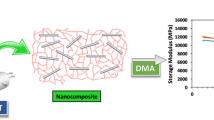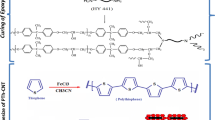Abstract
For the rational consumption of resources, humanity needs to invest in the creation of new composite materials. The main properties of new composites should exceed traditional ones by 4 times, and the energy consumption during their production should be reduced by 2 times. The relevance of this work lies in the search for technological solutions that can lead to the creation of new composite materials. Objective of the study: obtaining an epoxy composite with increased mechanical properties under tension using a biocompatible nanoscale filler-halloysite nanotubes (HNTs). The samples were made and tested according to the national standard of the Russian Federation GOST R 56800-2015. The current study provides an analysis of the tensile properties of the resulting composites in comparison with the literature. For the epoxy base, an epoxy composition similar to the literature was adopted. The following results were obtained: uniaxial tensile strength was improved by +18.19%, elastic modulus—by +6.54%, elongation decreased by −15.57% in samples containing 10 wt% halloysite. HNTs are also effective as a filler for epoxy composition. The research results presented in this article can serve as early support and reference materials for the creation of new epoxy-based composites using a tubular nanosized halloysite clay filler.
Access this chapter
Tax calculation will be finalised at checkout
Purchases are for personal use only
Similar content being viewed by others
References
Roser M, Ritchie H, Ortiz-Ospina E (2013) World population growth—our world in data. https://ourworldindata.org/world-population-growth#citation
Gavrilov MA (2014) Osobo plotnye epoksidnye kompozity na osnove othodov proizvodstva. PGUAS
Gojny FH, Nastalczyk J, Roslaniec Z, Schulte K (2003) Surface modified multi-walled carbon nanotubes in CNT/epoxy-composites. Chem Phys Lett 370:820–824
Khashaba UA, Aljinaidi AA, Hamed MA (2014) Nanofillers modification of Epocast 50–A1/946 epoxy for bonded joints. Chin J Aeronaut 27:1288–1300
Yohanes, Sekiguchi Y (2018) Synergistic effects of mixed silica micro-nanoparticles on compressive dynamic stiffness and damping of epoxy adhesive. J Dyn Behav Mater 4:190–200
Khostavan S, Fazli M, Ahangari MG, Rostamiyan Y (2019) The effect of interaction between nanofillers and epoxy on mechanical and thermal properties of nanocomposites: theoretical prediction and experimental analysis. Adv Polym Technol 2019
Li S et al (2020) Epoxy-functionalized polysiloxane/nano-SiO2 synergistic reinforcement in cryogenic mechanical properties of epoxy and carbon fiber reinforced epoxy laminate. Compos Sci Technol 198
Kinloch AJ, Taylor AC (2003) Mechanical and fracture properties of epoxy/inorganic micro- and nano-composites. J Mater Sci Lett 22:1439–1441
Hulugappa B, Achutha MV, Suresha B (2016) Effect of fillers on mechanical properties and fracture toughness of glass fabric reinforced epoxy composites. J Miner Mater Charact Eng 04:1–14
Dong C, Davies IJ (2014) Flexural and tensile moduli of unidirectional hybrid epoxy composites reinforced by S-2 glass and T700S carbon fibres. Mater Des 54:893–899
Zotti A, Zuppolini S, Borriello A, Zarrelli M (2019) Effect of SiO2@polydopamine core/shell nanoparticles as multifunctional filler for an aeronautical epoxy resin. Mater Today Proc 34:117–120
Ning N et al (2020) Impressive epoxy toughening by a structure-engineered core/shell polymer nanoparticle. Compos Sci Technol 199:108364
Thitsartarn W et al (2015) Simultaneous enhancement of strength and toughness of epoxy using POSS-Rubber core-shell nanoparticles. Compos Sci Technol 118:63–71
Ren X et al (2017) Critical rubber layer thickness of core-shell particles with a rigid core and a soft shell for toughening of epoxy resins without loss of elastic modulus and strength. Compos Sci Technol 153:253–260
Nigam V, Setua DK, Mathur GN, Kar KK (2004) Epoxy-montmorillonite clay nanocomposites: Synthesis and characterization. J Appl Polym Sci 93:2201–2210
Sudheer M, Vishwanathan KH, Raju K, Bhat T (2012) Effect of potassium titanate whiskers on the performance of vacuum molded glass/epoxy composites. J Reinf Plast Compos 32:1177–1187
Liu F, Deng S, Zhang J (2017) Mechanical properties of epoxy and its carbon fiber composites modified by nanoparticles. J Nanomater 2017:14–16
Di C et al (2019) Study of hybrid nanoparticles modified epoxy resin used in filament winding composite. Materials (Basel) 12:1–11
Mohammad Nejad S et al (2021) Nanoscale thermal properties of carbon nanotubes/epoxy composites by atomistic simulations. Int J Therm Sci 159:106588
Laurenzi S, Botti S, Rufoloni A, Santonicola MG (2020) Mapping the residual strain of carbon nanotubes in DWCNT/epoxy nanocomposites after tensile load using Raman microscopy. Compos Commun 21:100424
Pełech I et al (2020) Magnetic and electrical properties of carbon nanotube/epoxy composites. Mater Sci Eng B Solid-State Mater Adv Technol 254
Carbon nanotube products for polymers and batteries. https://tuball.com/additives/
Novosti KV (2020) Nanotrubki na nizkom starte – Ekspert – Novosti ekonomiki i politiki. Novosti segodnya. 24.02.2020. https://expert.ru/expert/2020/09/nanotrubki-na-nizkom-starte/
Joussein E et al (2005) Halloysite clay minerals—a review. Clay Miner 40:383–426
Massaro M et al (2018) Halloysite nanotubes for efficient loading, stabilization and controlled release of insulin. J Colloid Interface Sci 524:156–164
Wu K, Feng R, Jiao Y, Zhou C (2017) Effect of halloysite nanotubes on the structure and function of important multiple blood components. Mater Sci Eng C 75:72–78
Konnova SA, Sharipova IR, Demina TA, Osin YN, Yarullina DR, Ilinskaya ON, Lvov YM, Fakhrullin RF (2013) Biomimetic cell-mediated three-dimensional assembly of halloysite nanotubes. Chem Commun 49:4208–4210
Owoseni O et al (2015) Tuning the wettability of halloysite clay nanotubes by surface carbonization for optimal emulsion stabilization. Langmuir 31:13700–13707
Tarasova E, Naumenko E, Rozhina E, Akhatova F, Fakhrullin R (2019) Cytocompatibility and uptake of polycations-modified halloysite clay nanotubes. Appl Clay Sci 169:21–30
Adsul SH, Bagale UD, Sonawane SH, Subasri R (2021) Release rate kinetics of corrosion inhibitor loaded halloysite nanotube-based anticorrosion coatings on magnesium alloy AZ91D. J Magnes Alloy 9:202–215
Yendluri R et al (2017) Paclitaxel encapsulated in halloysite clay nanotubes for intestinal and intracellular delivery. J Pharm Sci 106:3131–3139
Xing X, Xu X, Wang J, Hu W (2019) Preparation, release and anticorrosion behavior of a multi-corrosion inhibitors-halloysite nanocomposite. Chem Phys Lett 718:69–73
Singer A, Zarei M, Lange FM, Stahr K (2004) Halloysite characteristics and formation in the northern Golan Heights. Geoderma 123:279–295
Vijayan PP, Hany El-Gawady YM, Al-Maadeed MASA (2016) Halloysite nanotube as multifunctional component in epoxy protective coating. Ind Eng Chem Res 55:11186–11192
Lisuzzo L, Cavallaro G, Parisi F, Milioto S, Lazzara G (2019) Colloidal stability of halloysite clay nanotubes. Ceram Int 45:2858–2865
Akbari V et al (2019) Surface chemistry of halloysite nanotubes controls the curability of low filled epoxy nanocomposites. Prog Org Coatings 135:555–564
Vahabi H et al (2018) Short-lasting fire in partially and completely cured epoxy coatings containing expandable graphite and halloysite nanotube additives. Prog Org Coatings 123:160–167
Ghaleb ZA, Mariatti M, Ariff ZM (2017) Synergy effects of graphene and multiwalled carbon nanotubes hybrid system on properties of epoxy nanocomposites. J Reinf Plast Compos 36:685–695
National standard of the Russian Federation GOST R 568002015, Polymer composites. Determination of mechanical tensile properties of unreinforced and reinforced materials for public use (2017). Retrieved from http://docs.cntd.ru/document/1200131391 on 26 Aug 2020
Jamal-Omidi M, ShayanMehr M (2019) Improving the dispersion of SWNT in epoxy resin through a simple Multi-Stage method. J King Saud Univ Sci 31:202–208
Acknowledgements
The authors thank the staff of SKB-ENGINEERING LLC for the opportunity to conduct this research.
Author information
Authors and Affiliations
Editor information
Editors and Affiliations
Rights and permissions
Copyright information
© 2022 The Author(s), under exclusive license to Springer Nature Switzerland AG
About this paper
Cite this paper
Tkach, E., Bichaev, M. (2022). Properties of Epoxy Composites with Halloysite Nanotubes Subjected to Tensile Testing. In: Akimov, P., Vatin, N. (eds) Proceedings of FORM 2021. Lecture Notes in Civil Engineering, vol 170. Springer, Cham. https://doi.org/10.1007/978-3-030-79983-0_8
Download citation
DOI: https://doi.org/10.1007/978-3-030-79983-0_8
Published:
Publisher Name: Springer, Cham
Print ISBN: 978-3-030-79982-3
Online ISBN: 978-3-030-79983-0
eBook Packages: EngineeringEngineering (R0)




